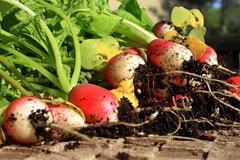
Radish, Cultivated radish
Latin Name: Raphanus sativus
USDA Hardiness: 2-11
Native Range: Greece, Italy, Sicilia, Yugoslavia.
Edibility Rating: 4 / 5
Medicinal Rating: 3 / 5
Region:
Family:
Plant Type:
Medicinal Uses
Edible Uses
Edible Parts: Flowers Leaves Oil Oil Root Seed Seedpod | Edible Uses: Oil OilYoung leaves - raw or cooked[37, 52, 104, 183]. A somewhat hot taste, and the texture is somewhat coarse[K]. As long as they are young, they make an acceptable addition in small quantities to chopped salads and are a reasonable cooked green[K]. A nutritional analysis is available[218]. Young flower clusters - raw or cooked[183]. A spicy flavour with a crisp pleasant texture, they make a nice addition to salads or can be used as a broccoli substitute[9, K]. Seeds - raw. The seed can be soaked for 12 hours in warm water and then allowed to sprout for about 6 days[244]. They have a hot spicy flavour and go well in salads[183, 244]. Young seedpods - raw[2, 37, 52, 104]. Crisp and juicy with a mildly hot flavour[K]. They must be eaten when young because they quickly become tough and fibrous[183]. Root - raw or cooked[2, 37, 52]. Crisp and juicy, they have a hot and spicy flavour and are a very popular addition to salads[183, K]. The summer crops do not store well and should be used as soon as possible after harvesting[K]. The winter varieties (including the Japanese forms) have much larger roots and often a milder flavour. These store well and can be either harvested in early winter for storage or be harvested as required through the winter[K]. An edible oil is obtained from the seed[2, 183].
Cultivation
Very easily cultivated fast-growing plants which prefer a rich light soil with ample moisture[16, 52, 264]. They dislike very heavy or acid soils[16, 37]. Plants are susceptible to drought and require irrigation during dry spells in the summer or the root quality will rapidly deteriorate and the plant will go to seed. Radishes are widely cultivated for their edible roots. There are many named varieties[183] that are able to supply edible roots all year round. Over the centuries a number of distinct groups have evolved through cultivation, these have been classified by the botanists as follows. A separate entry has been made for each group:- R. sativus. The common radish. Fast maturing plants with small roots that can be round or cylindrical and usually have red skins. They are grown primarily for their roots which in some varieties can be ready within three weeks from sowing the seed and are used mainly in salads. These are mainly grown for spring, summer and autumn use and can produce a crop within a few weeks of sowing. R. sativus caudatus. The rat-tailed radishes. This group does not produce roots of good quality, it is cultivated mainly for the edible young seedpods which are harvested in the summer. R. sativus niger. The Oriental and Spanish radishes. These are grown for their larger edible root which can be round or cylindrical and can be available throughout the winter. R. sativus oleiformis. The fodder radishes. These are grown mainly for their leaves and oil-rich seeds, they are used as a green manure or stock feed though they can also be eaten by people. The roots of these plants soon become fibrous, though they make acceptable eating when young. Radishes are a good companion plant for lettuces, nasturtiums, peas and chervil, tomatoes and cucumbers[18, 20]. They are said to repel cucumber beetles if planted near cucumber plants and they also repel the vine borers which attack squashes, marrows and courgettes[238]. They grow badly with hyssop[18, 20] and with grape vines[201].
Known Hazards
The Japanese radishes have higher concentrations of glucosinolate, a substance that acts against the thyroid gland. It is probably best to remove the skin[160].
Habitats
Not known in the wild.